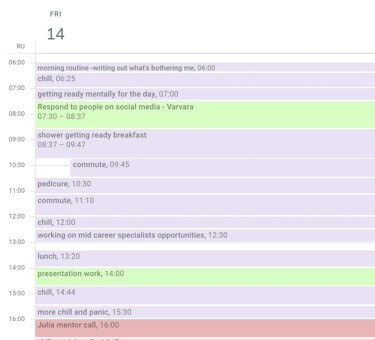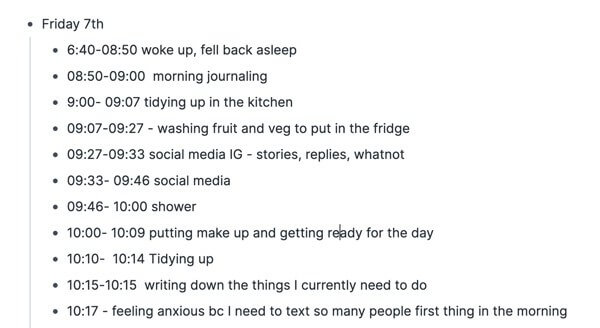Our writer, Ekaterina Sysoeva decided to track every minute of her day to see if she could be more productive. Here is what she found out from her week of research.
Spoiler: I got shook by how much time is actually spent on small talk, unexpected tasks, watching TV shows, and cooking!
At some point I got so frustrated about the constant feeling of overwhelm and invisible racing against the time that I decided to track every minute of my day for a week.
Now that the experiment is long over, let’s look at the findings, conclusions, and things that helped me regain ownership over my day.
Why I Wanted To Track My Time
Before the experiment, I felt busy but not efficient. I couldn’t ignore the sense that the time was slipping through my fingers and my days were looking like Groundhog Day all day every day.
I wanted to finally get clarity on where my time was going. I wanted to regain control over my decisions because I felt like I was living on autopilot being reactive, rather than being proactive.
Remembering the basic principles of conducting an experiment that I learnt in chemistry at college, I set out some ground rules, i.e. I defined the objective and the methodology.
The Objective
I realised that one week’s worth of time tracking wasn’t going to do miracles straight away so my expectations were more or less realistic.
First, I wanted to see what my schedule looked like.
I wanted to know what tasks I was doing on a daily basis and how, if necessary, I could optimise them/build them into a routine.
Secondly, I was curious how much time on average I was actually working in a day.
As a freelancer, the lines between work and life get blurred. More often than not, I find myself rejecting invitations to hang out because “I have so much work to do” or “I’m under strict deadlines”. I’d like to change that and to be more flexible. After all, isn’t freelance supposed to be about flexibility?
Finally, I wanted to determine the times I was most/least productive throughout the day.
This one is simple. The more concentrated I am, the faster my work gets done. This leads to a higher hourly rate and also allows me to have more downtime.
To stay consistent with tracking time, I needed to figure out the methodology for that. So I came up with a few rules.
Rules I Followed To Stay On Top Of The Experiment
There were just two of them:
- Throughout the week I wasn’t actively changing anything about my schedule. I was simply observing.
- I made a decision to write down the task and the timing straight away after I was done with it. To do that, I used either Google Calendar or a random note taking app on my phone/computer.
Here’s a glimpse into what the raw data looked like for a couple of days of the experiment.
Google Calendar Style

Roam research

The Trends
By looking at the everyday tasks, I noticed both positive and negative trends in where my time was going. Now that I’m writing this article three months after the experiment took place, I want to comment on my habits and whether or not I modified them.
Below are the trends I noticed.
I prefer planning in the morning.
Although many claim that planning the next day the night before is more beneficial, I prefer to start the day with it. I try to combine it with weekly planning sessions on Friday. This way I plan big tasks once a week and spend some time in the morning to arrange the smaller to-dos.
I naturally tidy up the apartment in the morning.
This one is tricky. Tidying up the first thing in the morning didn’t seem like a justifiable way to start the day. I thought that it was a waste of my productive time.
However, looking at it from a different angle helped. Tidying up, making myself a cup of coffee, and planning turned out to be my way of transitioning from waking up to starting work. Once I realised it was my alternative to ‘commute time’, I felt no guilt about it anymore.
No matter what time I fall asleep, I need 8.5 hours of it.
My attempts to wake up early even if I went to bed at 2am were unsuccessful. Something that would happen is I would do my morning routine and then fall back asleep for a couple of hours.
The experiment led me to two conclusions. First is that I was most productive if I slept for around eight and a half to nine hours. Second is that I shouldn’t schedule any meetings before noon. Not only does it eliminate the possibility of oversleeping, having mornings to myself also allows me to focus on my goals first.
How I stopped responding to clients first thing in the morning.
Working with clients, I’m always thinking about ways to deliver the best results for them. This sometimes makes me feel obligated to respond to their messages straight away.
For example, this entry above at 10:17am during the experiment accurately sums up the anxiety I experienced at the time:
What I do instead now is schedule my day around for main categories of tasks:
- Communications – responding to emails and social media messages
- Planning – setting goals and checking my to-do lists
- Content creation – anything from writing articles to working with clients
- Miscellaneous – minute tasks and chores around the house
TV and Tasks
I watched around TWO hours of TV shows every day.
I noticed an unhealthy habit of watching TV shows while having breakfast/lunch or dinner. And it would’ve been OK if I stopped after a 20-minute episode but sometimes one episode would turn into two or three.
To work on that, I stopped watching hour-long TV shows like The Firefly or The Hannibal with my meal. I can watch an occasional 20-minute episode of Bob’s Burgers but I’ve started making an intentional effort to stop and return to work.
Tasks take twice the time I allocate for them.
When I plan my days, I underestimate the time it takes me to complete the task. So I would run late or leave some tasks on my to-do list unfinished.
To change that, I simply double the time I think it will take me to work on something. I also don’t plan more than two or three priorities for the day to avoid feeling overwhelmed.
My go-to motto now:
“Under-promise, overachieve.”
Quick Facts
During the experiment that lasted from Friday 7th May to Friday 14th May, I spent 28 hours 45 minutes working, out of which the average weekday work time was five hours 15 minutes plus two and a half hours of work on the weekend.
Since responding to clients on social media is part of my job, I spent an average of 30 minutes on that with the maximum of 55 minutes on Friday 14th May.
I was the most productive in the mornings so I naturally had the most of my work before noon, meetings and call in the second half of the day, and repetitive tasks in the evening.
Being tired in the evening correlated with me binge-watching TV shows.
I had a bit of exercise (mainly walking) on four days out of eight days which is clearly not enough.
I had up to 80 minutes of random breaks with my partner during work hours.
Final Thoughts
Although the experiment only lasted for eight days, it was representative of my everyday life for the last year: lots of work, not enough exercise, and many goals to chase.
With some reflection, this little experiment helped me to define the things that were eating away my time and gave me sobering data for how much I was actually working.
“If you can’t measure it, you can’t change it.” (Peter Drucker)
Support us!
All your donations will be used to pay the magazine’s journalists and to support the ongoing costs of maintaining the site.
Share this post
Interested in co-operating with us?
We are open to co-operation from writers and businesses alike. You can reach us on our email at [email protected]/[email protected] and we will get back to you as quick as we can.










